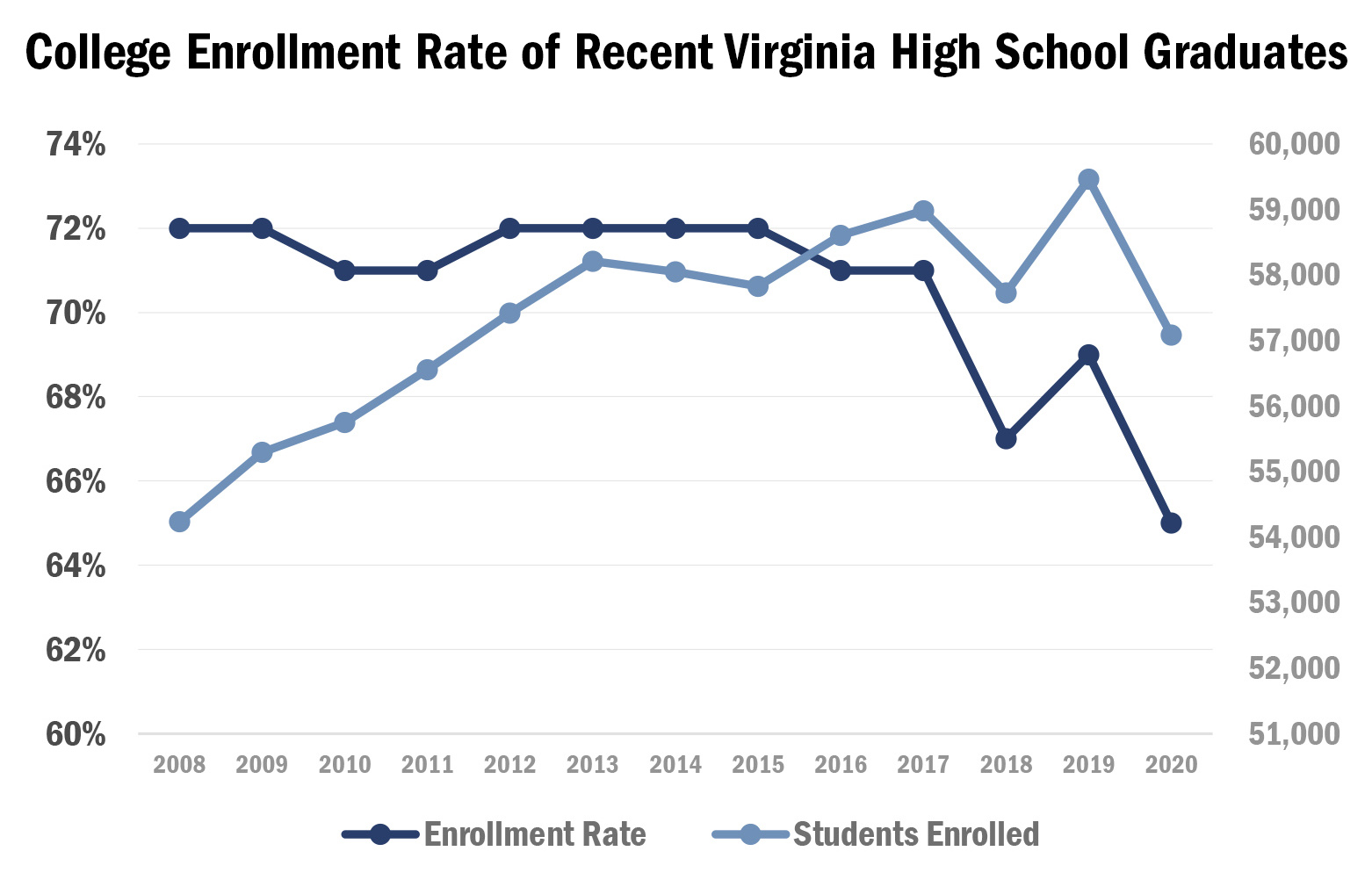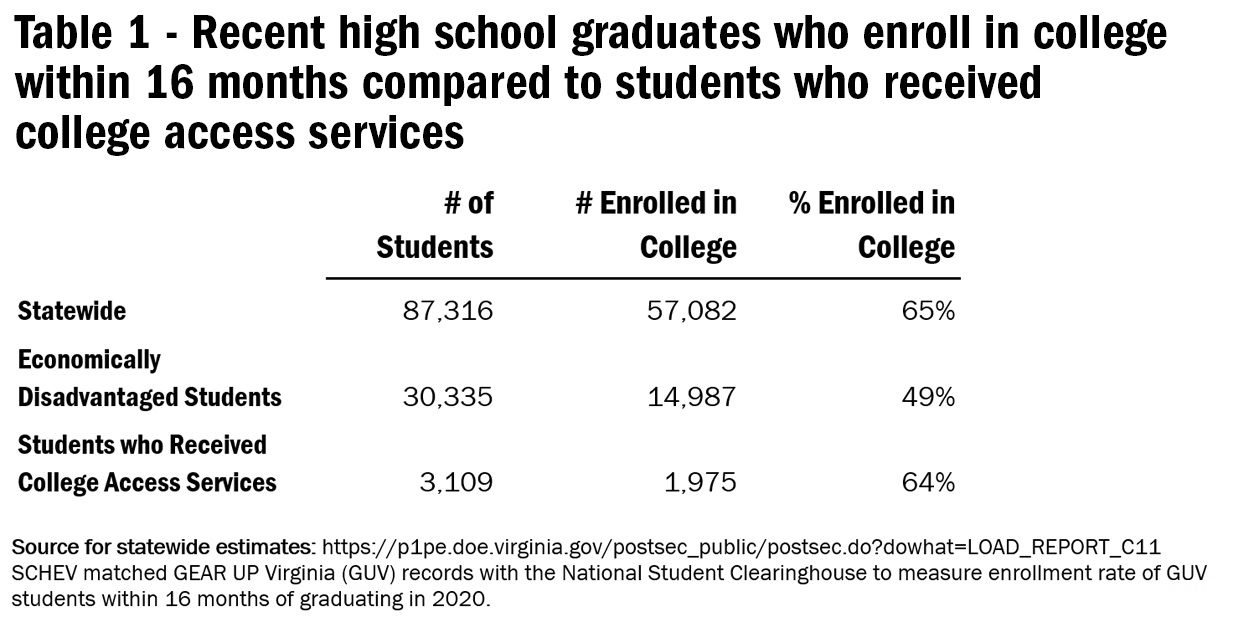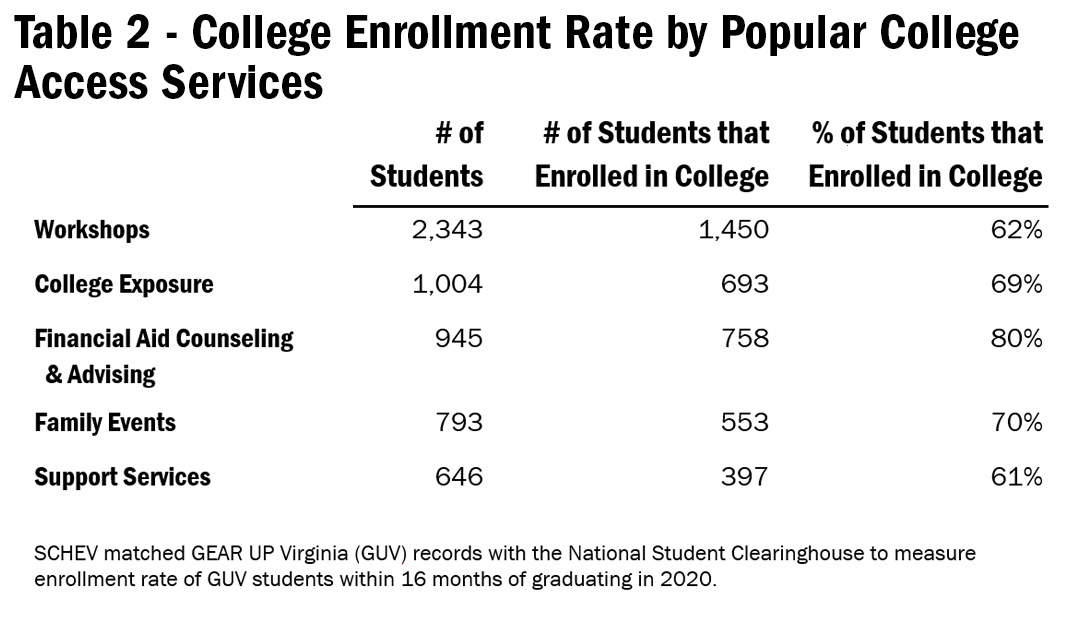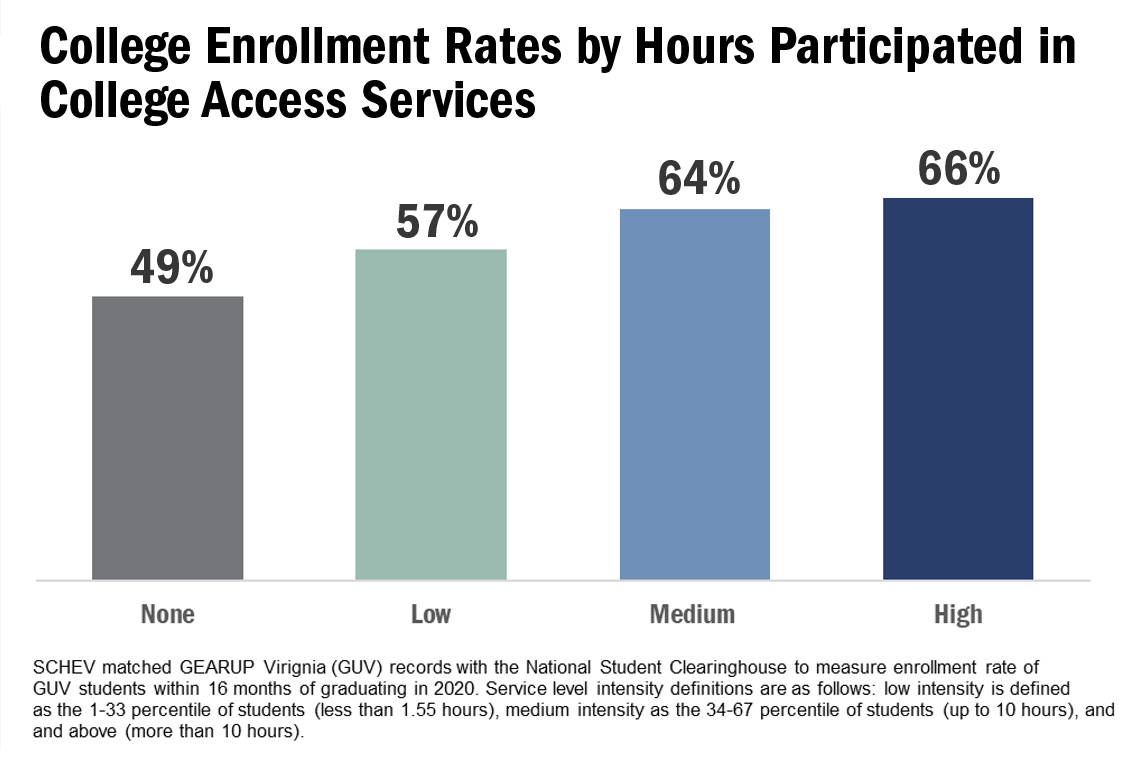By Anne Lowe & Tom Allison, SCHEV staff
Despite having stabilized this fall, college enrollment levels remain a topic of concern for institutions, policymakers and local community leaders. In 2020, over 30,000 students graduated from high schools but did not enroll in a college program within 16 months. As seen in the graph below, 65 percent of recent high school graduates enrolled in college, a decline from 72% just five years ago.
Looking ahead, SCHEV projects the pipeline of Virginia’s high school graduates to peak in 2026 and then gradually decrease by 6% by 2036. This impacts SCHEV’s Strategic Plan, Pathways to Opportunity: The Virginia Plan for Higher Education, which aims for 70 percent of all Virginians to have earned a degree or credential by 2030 (roughly the percent of all jobs that will need a postsecondary degree or credential). Achieving that goal starts with students enrolling in postsecondary programs in the first place. Postsecondary attainment also comes with economic and social benefits. College graduates earn higher wages, are more likely to have health insurance, pay taxes, vote and volunteer, and are less likely to rely on public assistance.

How College Access Services Close the Gap
Fortunately we have a model right here in Virginia for improving college-going rates for low-income students. GEAR UP Virginia (Gaining Early Awareness and Readiness for Undergraduate Programs) provides college campus visits, financial aid workshops, career counseling and academic tutoring services to students and families in select school divisions. GEAR UP, a federal grant program awarded to Virginia in 2021, has three main goals:
- Increase the academic performance and preparation for postsecondary education.
- Increase the rate of high school graduation and enrollment in postsecondary education.
- Increase students’ and their families’ knowledge of postsecondary education options, preparation and financing.
GEAR UP Virginia (GUV) operates on a cohort model, primarily serving a group of 7th graders as they progress through middle and high school and into postsecondary education. SCHEV selected the participating school divisions on numerous factors with concentration of low-income students as a primary focus. The previous cohort graduated high school in 2020. By combining GUV records with the National Student Clearinghouse, we can compare college-going rates between students who received GUV services with students in the rest of the state.
Students who received college access services enrolled in college at a rate of 64 percent. That is relatively similar to the statewide rate of 65 percent. School divisions were selected for GEAR UP in part due the economic disadvantage of its students, so we would expect these students to enroll at similar rates as economically disadvantaged students statewide. But economically disadvantaged students enrolled in college at just 49 percent.

Taking a closer look at the services themselves, patterns emerge about what type of programming may be associated with higher rates of college enrollment. Table 2 shows the most popular access services ordered by the number of students who participated. Informational workshops (as opposed to direct counseling or guidance in other services) are the most typical service. Students who participated in financial aid counseling and advising had the highest college-going rate of 80 percent.

The more services students participated in as part of the GEAR UP programming, the more likely they were to go to college. As seen in the chart below, students who received zero GEAR UP services enrolled at a rate on par with the statewide economically disadvantaged population.1 For students who participated in a moderate level of GEAR UP services, the gap seen in the statewide numbers closed completely. Students with 10 hours or more of access programming slightly outpace the statewide average.
1 Note: the higher than expected number of students who participated in zero (0) GEAR UP services could be due to an influx in GEAR UP students in the cohort’s final year, 2019-2020, when they were seniors. More students than expected left the schools, and the program allowed our schools to enroll in GEAR UP some students who had entered after the grant began. Different schools added different numbers of new students, as well as provided different levels of GEAR UP services.

The Takeaway
Enrollment levels at Virginia institutions will continue to be a concern for years to come as the number of high school students declines overall. The 30,000 students who graduate from Virginia high schools every year but do not enroll in college represent one strategy to address those concerns.
As seen in the numbers above, students who participate in college access services, like those provided by GEAR UP, enroll at college at higher rates than expected given their economic status. When given the opportunities and resources provided by programming from GEAR UP, or programming based on GEAR UP, as well as support from their schools and families, economically disadvantaged Virginians can attend college at the same rates as everyone else, eventually raising attainment rates, helping businesses find the workers they need, and generally improving the Commonwealth’s prosperity.
The Joint Legislative Audit & Review Commission (JLARC) recently studied the actuarial surplus at Virginia 529, the Commonwealth’s college savings plan. JLARC recommended that the General Assembly consider using a portion of the surplus to support higher education access and affordability. The report specifically cites GEAR UP and Virginia529’s SOAR Virginia program as potential effective strategies to increase access to higher education.
More analysis can and should be conducted to better understand the challenges and opportunities in connecting young Virginians to postsecondary education and training opportunities. More work can be done to explore enrollment rates by locality, the types of institutions in which students enroll, and other influences on college enrollment like FAFSA completion.
In the meantime, SCHEV will continue to host and coordinate college access activities around the Commonwealth, such as tax filing and FAFSA completion events in GEAR UP priority high schools (Hopewell, Petersburg and Brunswick). Students and families will receive hands-on assistance from college access providers to file applications for state and federal financial aid, as well as assistance from tax preparers to file their 2022 taxes. These services are being piloted with the hopes to create a program in the future based on these financial service days that can be rolled out statewide.
Notes
GEAR UP Virginia served a relatively narrow slice of Virginia high school students, four percent (3,934 students participated in GUV 3.0, compared to 87,316 students statewide) of Virginia’s graduating Class of 2020. The majority of the students came from high need or recognized need school divisions in Virginia (13 out of 15), where there was a division-level need to increase college enrollment, or there was a high level of economic disadvantage within the school division.
The trends above are correlational. Students who are more motivated to go to college in the first place may be more likely to participate in services. However, more rigorous research has established the causal relationship between access services like GEAR UP.
The college enrollment report hosted by the Virginia Department of Education includes only two-year public institutions, four-year public institutions, and four-year private, non-profit institutions. Some GEAR UP Virginia students chose to attend for-profit two-year and four-year institutions of higher education, as well as a private non-profit two-year institution.
Welcome to Insights, SCHEV's platform to interpret and communicate data and policy with the overall goal of informing policy-making, engaging institutions and drawing attention to these resources. Centered around SCHEV's nationally leading data collection, each Insight will visualize complex ideas and help inform funding and policy decisions.
